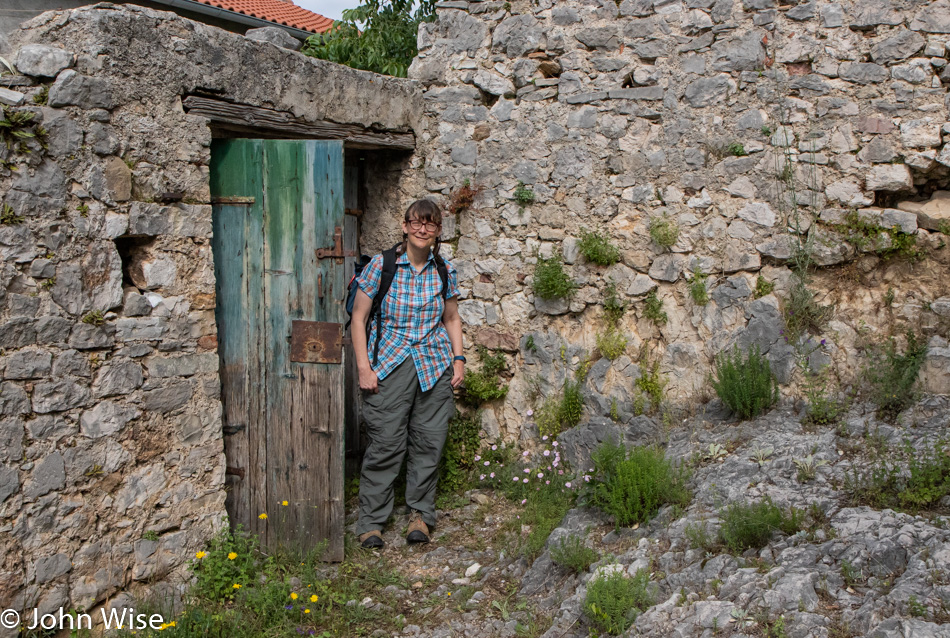
This next bit is not about our Balkans adventure, but it is what I was writing about at breakfast time before we ventured out for our big day of exploration, seeing another million new things.
Today, Caroline and I are just 18 days away from celebrating the 30th anniversary of our fairytale romance when we were both swept off our feet. It did not start with a conversation, though we had spoken numerous times. It did not start with long phone calls where we learned about one another. It started with a kiss.
By the time that happened, it was late in the night, or maybe it was early in the morning. Earlier in the evening, we both happened to be at a concert by the Pixies at the Batschkapp in Frankfurt. We had met at a few shows previously, so we ended up talking outside after the concert until it had gotten late I suggested I give her a ride home, and she accepted. At her place, we talked about her impressive book and record collections, and soon, it was 5:00 in the morning, and I needed to get home.
Caroline walked me to my car through the maze of her neighborhood as she wasn’t sure I’d remember where I parked on those crowded streets. At my car, we kissed, not an aggressive, forceful thing but the most passionate, soft meeting of the lips that barely touched. That delicate moment hung there, lingering forever, and we returned to it again and again to this day.
In the intervening years, we have endured the trials and forces of growing together that, with occasional severity, have tested our bond and sometimes good sense to stay together through our idiocy and shenanigans, but here we are 30 years later, 25 of them married and we still get lost staring into each other’s eyes. I know my wife’s vulnerabilities, and she knows mine. As we’ve grown older, we matured, trying not to exploit those soft spots as much as we did in the early days. Mostly, we try to understand one another and discuss our issues, but emotional heights can still have precipitous falls.

We are imperfect like most everyone else, though I believe too many others wear the mask of perfection as they attempt to delude others of their grandeur instead of embracing the warts of their humanity. In this context of awareness of faults and weakness, we are still trying to overcome ourselves to discover the hidden parts we might not have encountered yet or packed away into our inner schweinehund (Literally translated as ‘inner pig dog or the weak or lazy part of one’s nature).
It could be characterized that Caroline and I are living a kind of modern hunter-gatherer experience. In hunting for opportunity, we gather shared memories that form the still-evolving arc of our story. In work and routine, we try to manage a healthy symbiosis of responsibilities that involve hunting for the economy to feed our bills and caloric needs while gathering knowledge from how our free time is able to be spent in learning and crafting.
While I’m aware of these primitive human characteristics, I’m also highly aware of the esoteric rare earth elements that arise from those who attempt to express themselves through art, science, music, thinking, and occasionally politics. We are on a quest to explore these metaphorical distant lands to find treasures the rest of the tribe will find value in. This also applies to the relationship we are nurturing. Every day, I search for that thing that may bring a smile to our faces and lend approval that one of us has found sustenance, allowing us to survive another day.

Through the collective efforts of Caroline and me playing these roles of hunter-gatherer, we are absolved of needing to be active participants in the agrarian culture as industrialization took away that demand. Regarding the industrialization of society, we are both in rebellion against being trapped like a cog in the machine. In effect, we were catapulted back towards humanity’s earliest responsibilities but as modern interpretations of what it means to hunt and gather.
Because we humans have this language facility that often languishes or, at best, runs along on a treadmill of repetition, we do not stretch to escape the path that runs in circles. Instead of scaling the imagination and mind, we reach for the physical and the beautiful, which are archaic relics of previous ages when those attributes lent wealth and power to those who could cultivate those strengths.
The Enlightenment hinted at our most human traits found in our intellect and creativity while modernity is using a digital mirror to amplify the superficial fringe of nonsense reflecting the abyss and the monster of our primitivism. I dream of the age when we are allowed to forget the animal within and ascend the potential heights of our humanity.
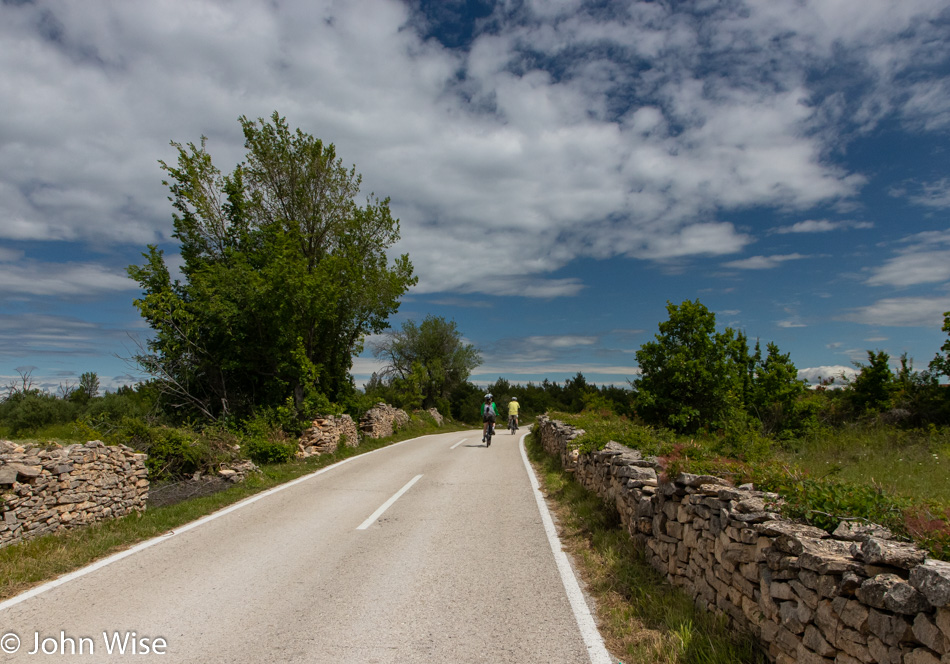
After breakfast and a walk around Skradin that took us up to the old fortress, some of the group departed for a day of sea kayaking while seven of us went for a bike ride. Normally I’d struggle with a 12% grade on a mountain road and would have likely had to push the bike up the entire mile had this been any other day. This incline, though, didn’t represent any serious problem for us today because we were on electric-assist bicycles.
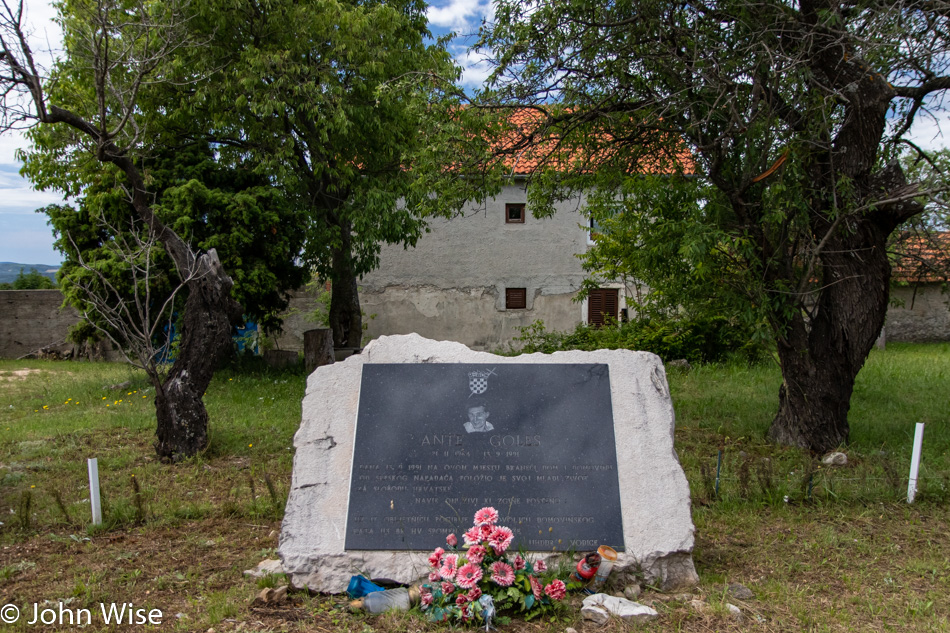
Along the way, we passed a vineyard, had a great overview of the city below after climbing the mountain, and passed this roadside grave in the village of Dubravice. The marker is for Ante Goleš, who appears to have died in the Balkans conflict at the age of only 26 years old. I can find nothing about him on the internet, maybe because he died before the age of it. Today, I wanted to acknowledge this anonymous person whose life was extinguished before he likely was ever able to explore the breadth of experiences that Caroline and I have been so privileged to seek out.

This was the first destination of our 34km (21 miles) bike tour of the Croatian countryside: the island of the Visovac Monastery. We were not prepared to row out to the island as this was simply a stop along the route into Krka National Park.

These electric assist bikes we are on have changed my life. When we started up the mountain, I was certain I’d have to push at least part of the way, but all I needed to do was change to high-power and keep on pedaling, and about 15 minutes later, we were overlooking Skradin. When we get home, I’ll be making a serious investigation into getting two bikes so Caroline and I can revisit many of the places we’ve wanted to pass through slower than we did in the car but faster than we could on foot.
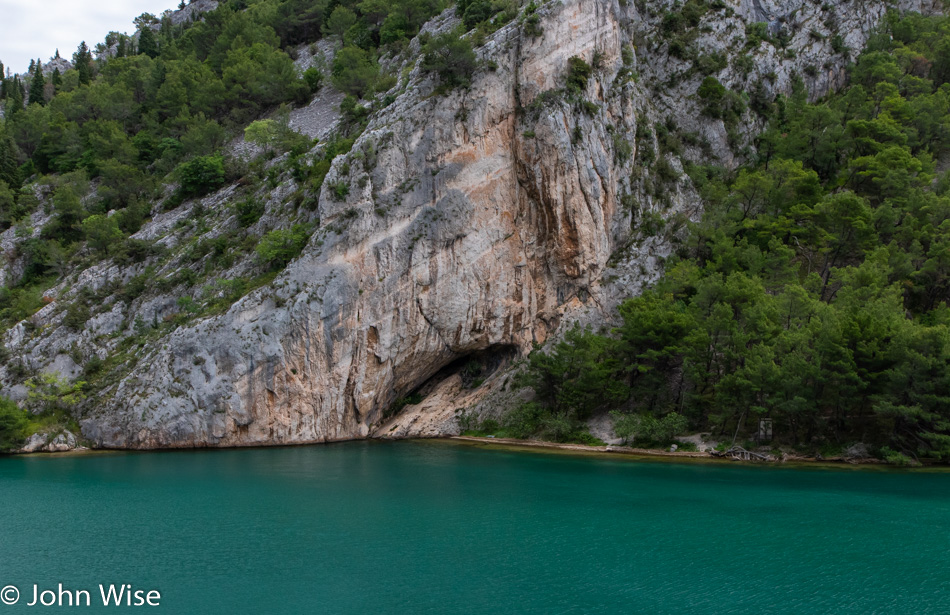
We weren’t done with our ride quite yet as we were on our way into the part of Krka National Park that draws the most visitors, but instead of taking the boat as most do, we were able to ride along the pedestrian path.

After locking up the bikes and taking a much-needed pitstop for toilets and a bite to eat, there was time to check out the flowers before moving further into the park for the main attraction.
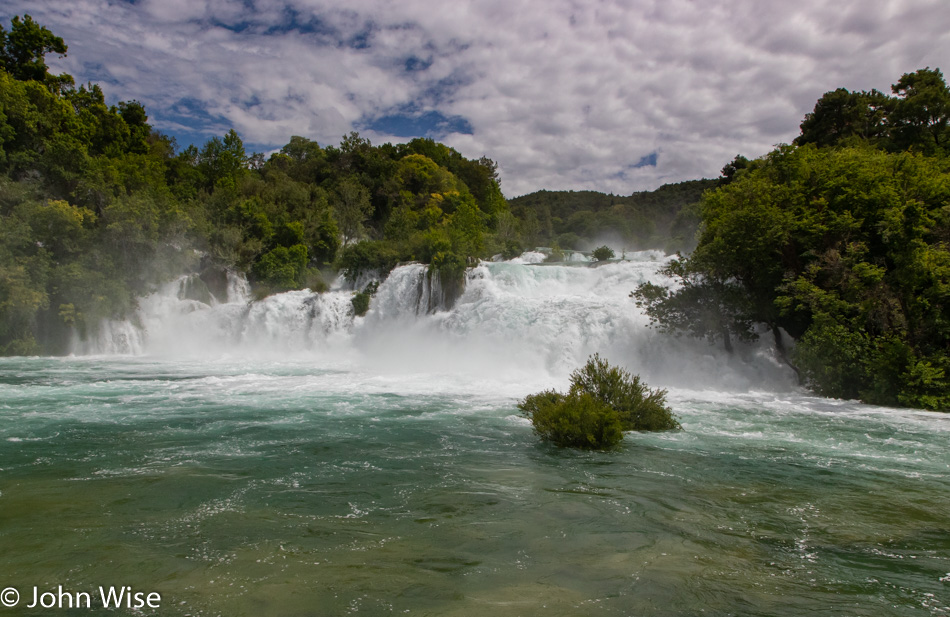
These are the waters that, back on August 28th, 1895, powered the world’s second hydroelectric power generator. Two days prior, at Niagara Falls in New York, the most famous hydroelectric generator was started, but it was the town of Šibenik here in Croatia that was the first city on earth to have alternating current-powered lights on its streets.
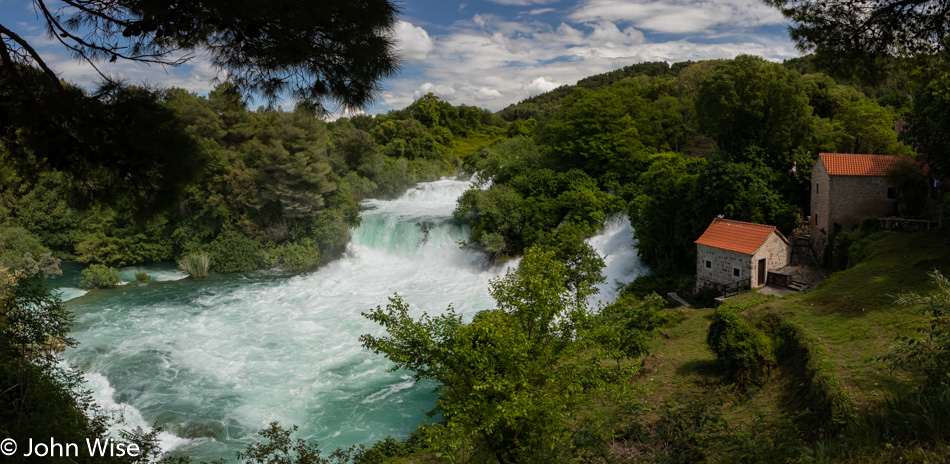
I would have been thrilled if Plitviče Lakes National Park had been the only place in Europe where I might see the type of waterfalls we witnessed, but yesterday in Slunj, we were again presented with spectacular flows of water. Now here in Krka, we are once more astonished by how incredibly deft Croatians are for bringing us right to the edge of rushing water and letting us pass just inches above it.
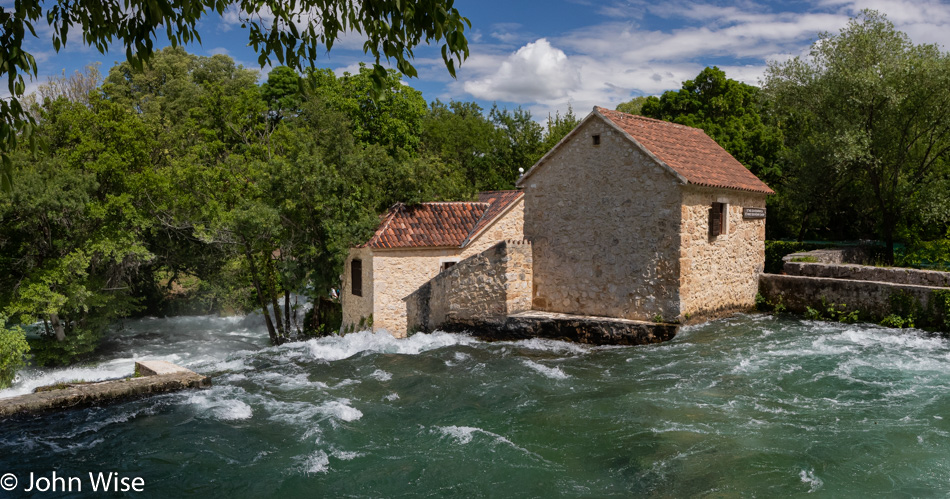
Instead of working at the shore, the Croatians go right into the middle of the maelstrom and build paths and houses right in the flow. It’s exhilarating to walk this close to fast-moving water.
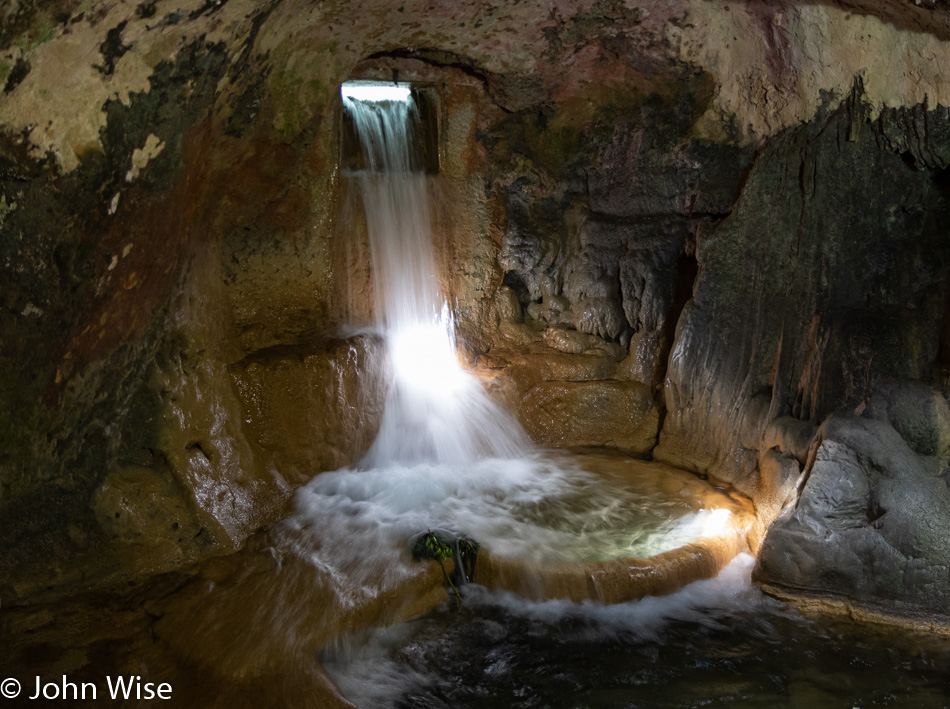
A small enclave among the buildings in the middle of a part of the river has water running right inside, with the travertine still growing.
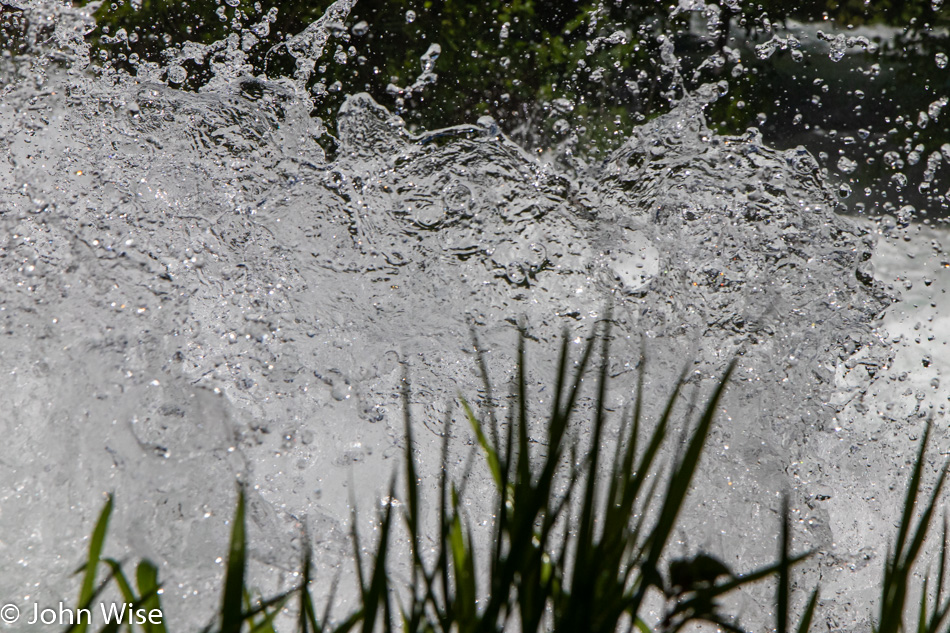
We are just inches away from a powerful cascade of water that occasionally sends a splash of water over the retaining wall and right into the face, my face, to be more precise.

Our time is short here in the park as we still have another scheduled activity for the entire group, and the others are likely wrapping up their sea kayaking right about now.

The path we came in on is the same one we are departing on. As I said, most visitors enter the park on a shuttle boat that brings them from Skradin on an inlet of the Adriatic up the Krka River, so our trail is a peaceful and quiet ride in the canyon high above the water. Once we were back in town, we were just as quickly back in the vans on our way to the next destination.

Welcome to Zadar. While evidence of human habitation stretches back to the Stone Age, it is the Romans and Venetians who left a lasting impression upon the oldest continuously inhabited city in Croatia. While we won’t be joining the ranks of history as a conquering force entering the city, we will be indulged in hanging out for a few hours.

The impressions come on fast as we walk by the port, heading into one of the gates that people have been passing through for centuries.

Our first stop will be at a restaurant for dinner, where we have reservations for our group. The place is called 2Ribara with the number two being pronounced as “dva” and Ribara meaning “Fishermen.” Along the way, I’m nervous about losing any available daylight, so I start snapping photos of everything.

Turns out that we’ve arrived in Zadar during Ethno Days which is a festival running from mid-March thru June 1st in cooperation with the National Museum of Zadar. The folklore side of the fest has brought out many groups from the surrounding areas who are sharing their unique clothes and music with visitors to Zadar today.

When you live in Phoenix, Arizona, and all of the architecture looks nearly identical, small glitches in the matrix make for ecstatic sighs when we look at what others consider to be mundane or normal. The same thing happens to Caroline and me when we are among trees and other things that are deep green; we want to bring it all home with us, so we should never forget what real green looks like compared to desert tan green.
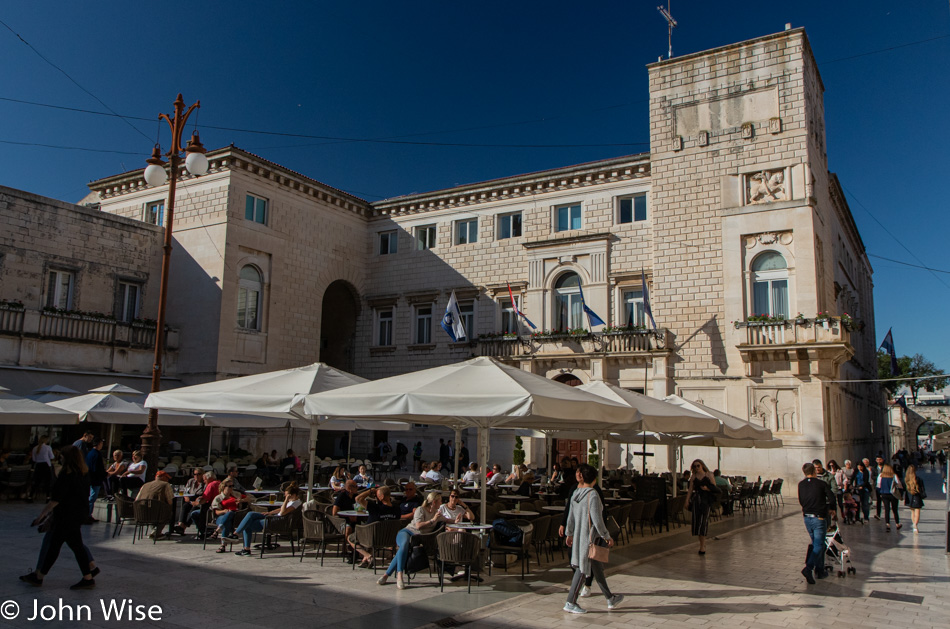
Can you smell that? Probably not, so let me tell you what I’m referring to. It’s late in the day, and we are surrounded by history and the sea, where the two combine to intoxicate you into believing this might be one of the greatest places to live. Then you hear someone speaking Croatian nearby and realize you will never own enough vocabulary beyond some obligatory curse words, a few numbers, and various greetings appropriate to the time of day, but how you do things, like get the electricity to your newly rented apartment in your name, will have you running for the border to return home. So this ends up being the smell of fear that you are falling in love with the forbidden fruit of desire.
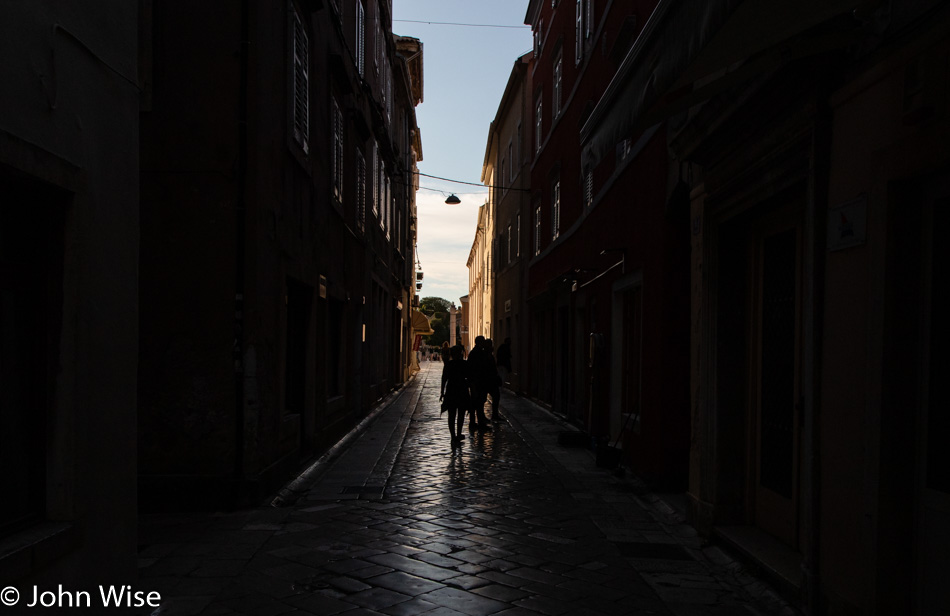
How many streets can I photograph with surfaces polished by the incredible number of feet that walked over them? I can photograph all of them as the reflections are magic in my eyes.
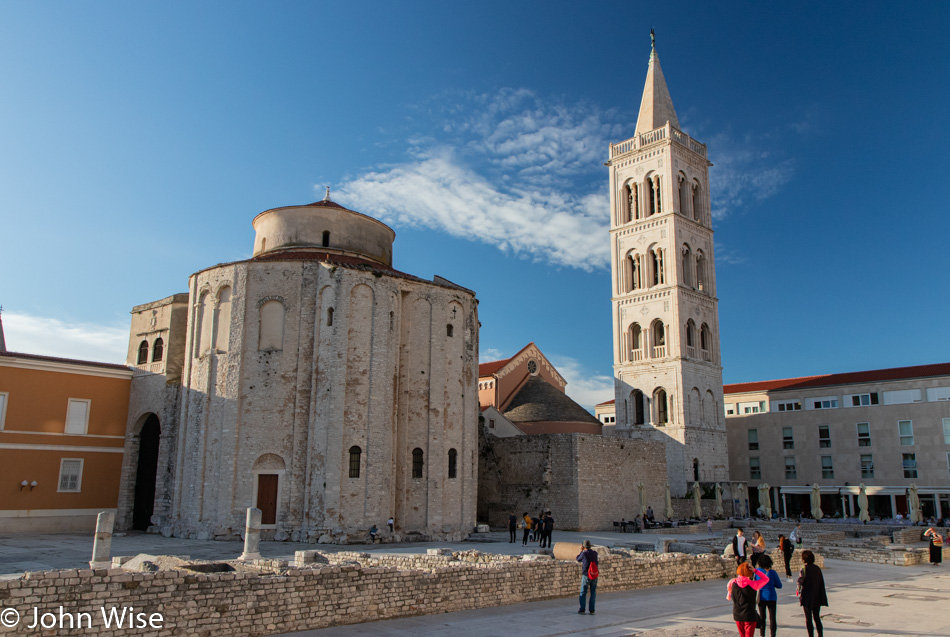
On your left is the Church of St. Donut. The bottom of the church started as a kind of fritter, but by the time they reached the top, it was realized that it should be round like the deep-fried cakes St. Donut used to make in the Bible. Okay, I was joking with you; Donut was a bishop and diplomat in the 8th and 9th centuries and was never mentioned making donuts in the bible. He is recorded as having made donuts in Constantinople for Charlemagne. This brings us full circle (another donut reference) to Frankfurt, named during Charlemagne’s rule, who, after putting sausage into a sliced donut, created the hot dog, which was modified after relish was invented. Oh wait, Caroline is informing me that the church was built by and named after St. Donatus, who created the Döner Kebab! I hope God can’t read.
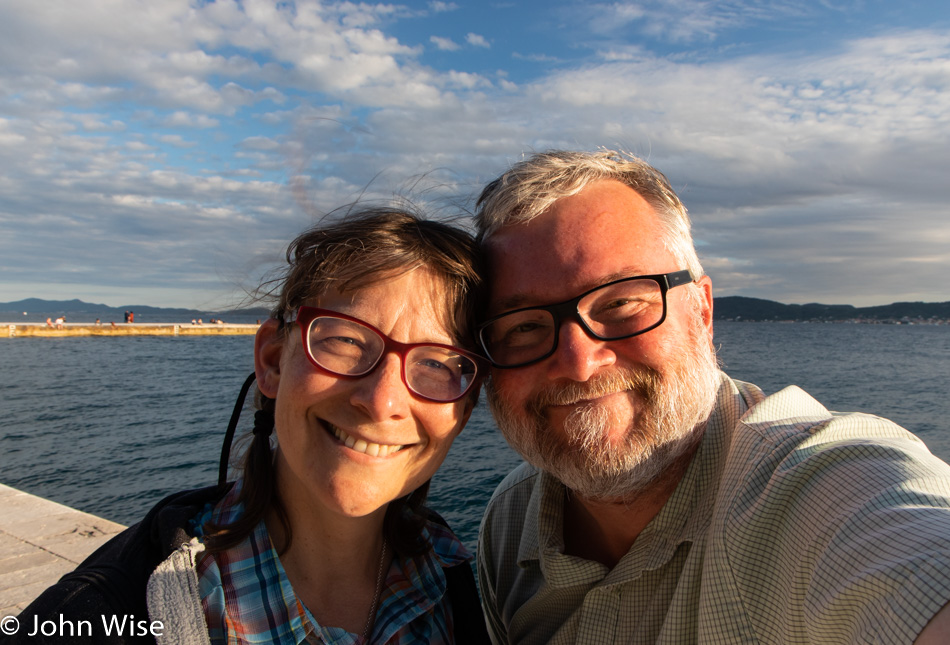
Sadly our visit to the Greeting to the Sun monument was marred by an idiot who, earlier in the day, worked hard to destroy the popular attraction in Zadar near the Sea Organ. Taking a photo of the smashed monument or trying to capture the essence of the Sea Organ with photos were not going to work here, so instead, I present our smiling faces that were just happy to be here listening to the sea bellowing at us and people enjoying the late afternoon.

Pre-sunset photos are where ideas of the grandeur of the approaching sunset let one know that they need to be around for that moment when the sun actually sets. This will also act as the signal that we tourists need to go find our group and get out of Dodge or Zadar.

We are racing through town on Caroline’s behalf as there’s just one more thing she really really needs to make the day complete. We’d seen what she so badly desired earlier, but our mission at that time didn’t allow us to just hang out, so with serious purpose, we were combing Zadar on the lookout.
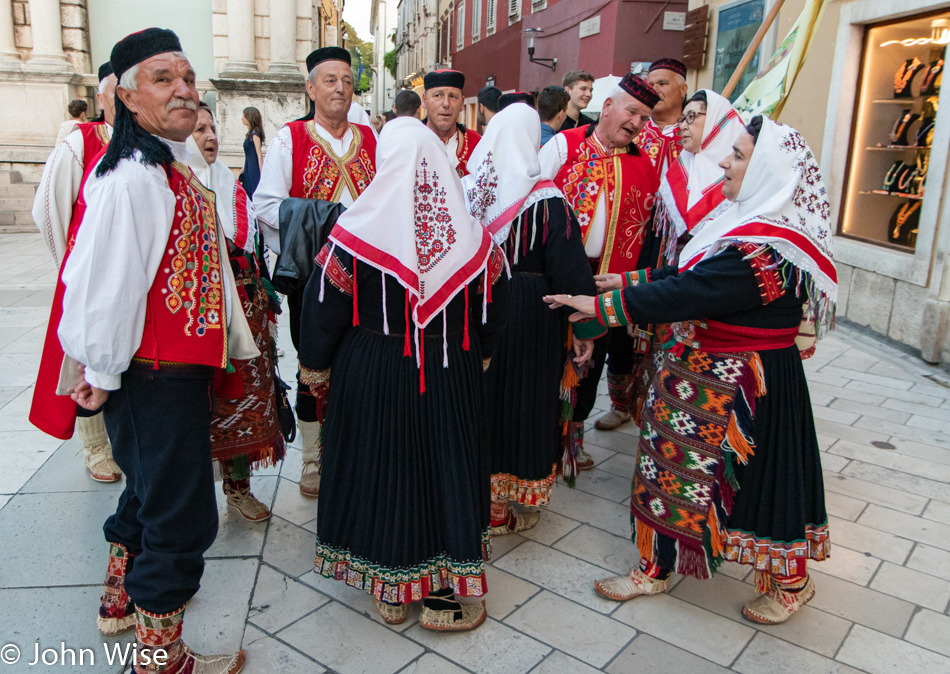
We found them or at least one group of them. These roving singers are meandering through the old city, singing folk songs. From our understanding, they come from the surrounding countryside and bring with them a banner showing exactly where they are from. Their acapella songs are hauntingly beautiful, while their clothing is festive and quite elegant in our eyes.
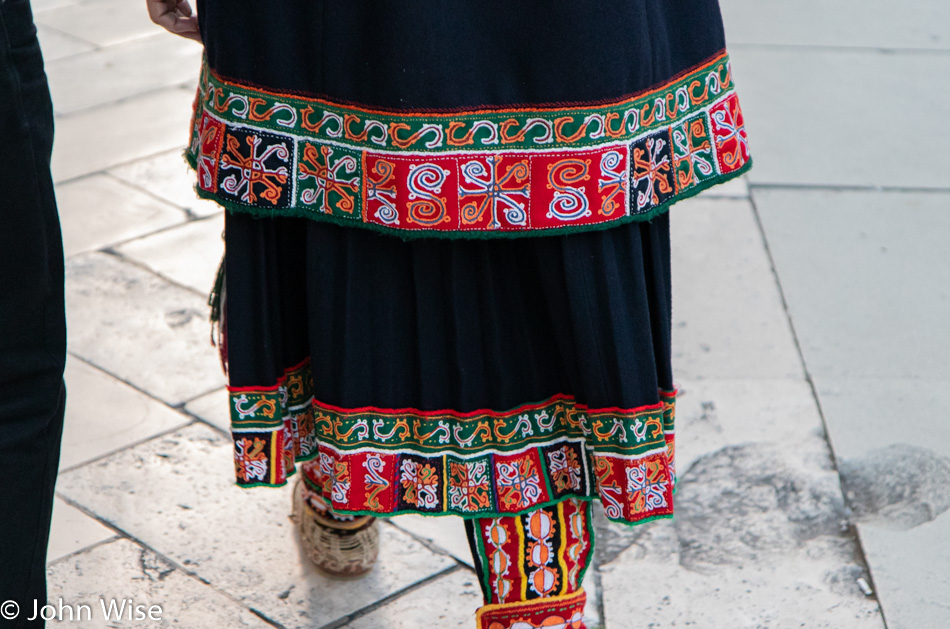
From this point, you can guess correctly that Caroline is intrigued by the clothing that is screaming at her inner fiber artist to join the club and acquire something with these motifs. Fortunately, our time is limited here in Zadar, and Caroline is astute enough to know that the majority of this stuff must be handmade, so it will not be found in shops that sell skimpy bikinis and gold glitter shoes, which appear to be the hot item in Croatia right now.
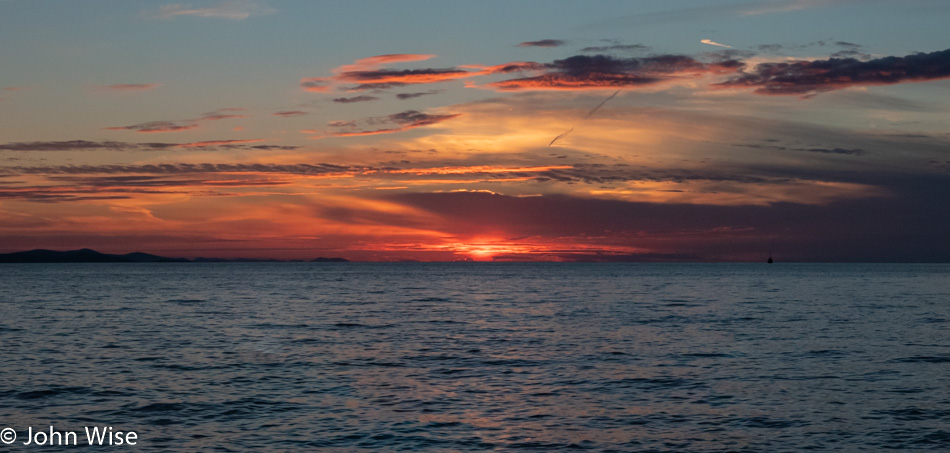
Back at the sea, we are on hand with half of Zadar to watch the sun dip below the horizon.

The leggings John, please take a picture of the leggings. “Oh, that will work out great as the old fat guy chases the teenagers trying to photograph their legs and then explains to the policeman that I do not have a fetish where I’ll be selling Croatian foot photos on the internet.” How about we just ask them to pose with you?
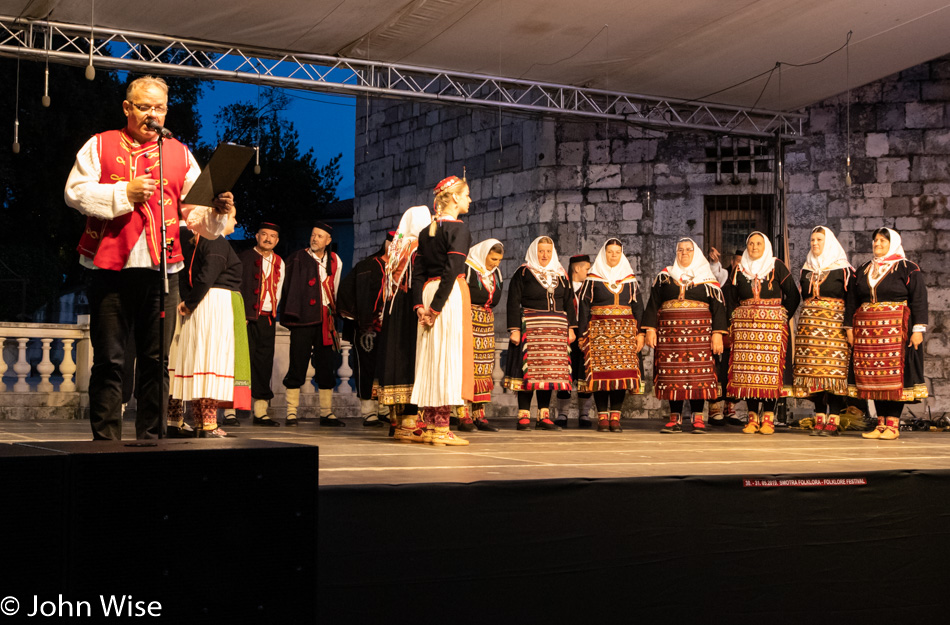
The folk music and dance event had already started and we only know of it because we could hear their performance from a block away as we were heading for the town gate. So we ran from our group, promising to catch up in order to at least have a glimpse of the gathering. Now that we are fully aware of Ethno Days, maybe we’ll try to schedule a proper visit to Zadar in the future so we can see more of the events that happen over the more than two months of festivities.

Wait for us, everyone; we’re almost there.
Back in Skradin, we had the briefest of briefings regarding tomorrow; what those details were I can’t say because I wasn’t really paying attention. Ten seconds after Petar started, he finished, and with that, the group dispersed and apparently were off to bed. At the bar, the night crew took over, that being myself, Caroline, Petar, Ivan, Cliff, and our newest addition, Matt. It was already getting late when Mičo showed up. This well-traveled and likely drunk boatman is a good friend of everyone who is anyone in the Balkans world of rafting. The guy is incredibly charismatic, even when he’s inebriated. He spent a good long time barely allowing a word in edgewise as he regaled us with sage advice about life lessons.
Finally, after midnight, we crawled upstairs with our sore haunches from the bike ride that took its toll on our tender sides, not accustomed to the cruelty of small bicycle seats. Facing yet another night of barely six hours of sleep hardly matters when compared to the wealth of impressions that work to fill the deficit days after we return to our routines. Back home, we struggle to find novelty; out here, it presents itself with every waking moment.